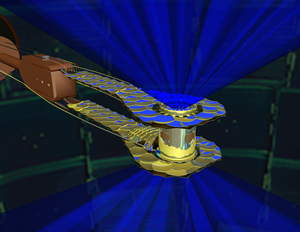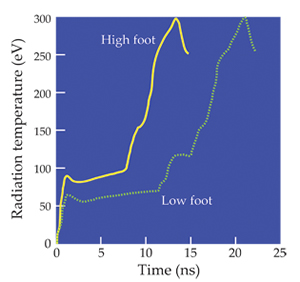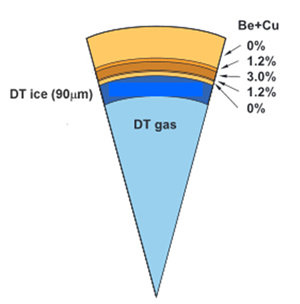Photons & Fusion Newsletter - 2014
February
Photons & Fusion is a monthly review of science and technology at the National Ignition Facility & Photon Science Directorate. For more information, submit a question.
Nature Article Reports on Fuel Gain Achieved In NIF High-Foot Experiments
A key step on the way to ignition on NIF is for the energy generated through fusion reactions in an inertially confined fusion plasma to exceed the amount of energy deposited into the deuterium-tritium (DT) fusion fuel and hot spot during the implosion of the target capsule—a condition known as “fuel gain.” An article in the Feb. 12 online issue of the journal Nature reports that through the use of the “high-foot” implosion process developed by the NIF/Weapons and Complex Integration team, fusion fuel gains exceeding unity have been achieved for the first time on any facility.
An article in the Feb. 12 online issue of the journal Nature reports that through the use of the “high-foot” implosion process developed by the NIF/Weapons and Complex Integration team, fusion fuel gains exceeding unity have been achieved for the first time on any facility.
The experiments show an order-of-magnitude improvement in yield performance over previous NIF shots as well as a significant contribution to the yield from alpha-particle self-heating, in which the alpha particles (helium nuclei) produced in the DT fusion process deposit their energy in the DT fuel. The alpha particles further heat the fuel, increasing the rate of fusion reactions, thus producing more alpha particles. This “bootstrapping” process is the mechanism required to accelerate the DT fusion burn rate to eventual self-sustaining fusion burn and ignition.
The high-foot experiments feature a higher initial laser pulse than previous “low-foot” shots, shorter pulse duration, and three laser shocks on the target rather than four. This configuration is designed to reduce ablation-front instability growth and thereby inhibit plastic ablator material from mixing into and contaminating the DT hot spot. The essential stability benefits of the high-foot scheme can be seen in a reduction in the linear growth rate of ablation-driven Rayleigh-Taylor hydrodynamic instability.
“The increase in density gradient scale-length of the ablation front is primarily due to the stronger first shock, which increases the adiabat (internal capsule energy) of the implosion and prevents the ablator from becoming so highly compressed (risking break-up) during the implosion,” the authors said. For more information, see the LLNL News Release.
Results of Initial High-Foot Experiments Also Reported in Physical Review Letters
The performance of the first DT layered implosions on NIF using a high-foot, higher adiabat (internal capsule energy) design also was reported in a Physical Review Letters paper published online on Feb. 5. The intensity of the laser pulse delivered to the hohlraum changes with time. Previous NIF experiments used a “low-foot” drive (dotted yellow line), in which the first stage of the pulse (the “foot”) delivered a relatively low power. Using a high-foot drive (solid yellow line) instead delivered a higher neutron yield that was more consistent with simulations. The radiation temperature, which characterizes the radiation field in the hohlraum that drives the implosion, is plotted against time. (Credit: APS/Joan Tycko) The paper also was the subject of a “Viewpoint” article, “Encouraging Signs on the Path to Fusion,” by Steven Rose, professor of plasma physics at Imperial College London, in the American Physical Society’s online journal Physics.
The intensity of the laser pulse delivered to the hohlraum changes with time. Previous NIF experiments used a “low-foot” drive (dotted yellow line), in which the first stage of the pulse (the “foot”) delivered a relatively low power. Using a high-foot drive (solid yellow line) instead delivered a higher neutron yield that was more consistent with simulations. The radiation temperature, which characterizes the radiation field in the hohlraum that drives the implosion, is plotted against time. (Credit: APS/Joan Tycko) The paper also was the subject of a “Viewpoint” article, “Encouraging Signs on the Path to Fusion,” by Steven Rose, professor of plasma physics at Imperial College London, in the American Physical Society’s online journal Physics.
The authors said the high-foot implosions generated YOC (yield over simulation predictions of yield) greater than 50 percent, bringing experiment and simulations into closer agreement. DT neutron yields exceeding 1015 (one quadrillion) in cryogenic layered implosions were achieved for the first time; and a 50-percent yield boost due to self-heating of the fuel by alpha particles (helium nuclei) emitted in the initial reactions was observed, another first.
“The results have been very encouraging,” the authors said. “The comparison with the low-foot, low-adiabat series of implosions is interesting and instructive.” The high-foot series used a shorter, three-shock drive with a higher foot, and produced a higher fuel adiabat, higher yields, less mixing of ablator material into the DT hot spot, but modest fuel areal densities. The low-foot series of implosions used a longer, four-shock drive, and produced a lower fuel adiabat, lower yields, higher hot-spot mix, but higher fuel areal densities.
“Creating a higher adiabat and higher radiation temperature early in the drive appears to be an effective means for reducing hot-spot mix by reducing ablation front (hydrodynamic) instability growth,” the authors said. “Future work will focus on avenues for increasing the fuel velocity and areal density while holding ablation-front (instability) growth and hot-spot mix under control, to approach the conditions required for ignition.”
A companion paper describing the design and theory behind the high-foot experiments was published in the same issue of Physical Review Letters.
Shock Timing Measurements and Analysis Described in Physics of Plasmas
Recent advances in shock timing experiments and analysis of cryogenic deuterium-tritium (DT) ice layered capsule implosions on NIF provide a new capability for capsule-centric assessment of the effects of hot-electron preheat on DT ice layers in ignition implosions. The results were reported by LLNL researchers and colleagues in a Physics of Plasmas paper published online on Feb. 12.
The researchers said comparison of experimental results with simulations shows good agreement for the timing of the first three shocks in four-shock DT ice layered implosions, but reveals a considerable discrepancy in the timing of the fourth shock attributable to electron preheat. The Velocity Interferometer System for Any Reflector (VISAR) data and analysis techniques add to the experimental constraints and may alter the previous understanding of implosion behavior.
The results also suggest promising directions for improvement of implosion performance, the researchers said. Recent implosion experiments performed in near-vacuum hohlraums, for example, effectively eliminate stimulated Raman scattering (SRS) instability and consequently remove this component of hot-electron preheat. Other recent experiments using higher-Z dopants such as neon in the hohlraum gas fill have demonstrated a fourfold reduction in hot electrons measured by the filter fluorescer diagnostic (FFLEX). Both of these techniques provide hohlraum environments that can either substantially reduce or even completely eliminate a major component of hot-electron preheat.
Future experiments combining these new hohlraum environments with the new capability for making VISAR measurements in DT layered keyhole targets will quantify the impact of these changes on electron preheat in DT ice layers. Lead author Harry Robey was joined by LLNL colleagues and collaborators from the Laboratory for Laser Energetics at the University of Rochester and General Atomics in San Diego.
An Optimized Beryllium Capsule Design for NIF Implosions
Target capsules (ablators) in NIF experiments to date have been made of germanium or silicon-doped plastic, or undoped diamond-like high density carbon (HDC). Beryllium (Be) is believed to present another, more attractive, ablator material option.  Structure of the NIF Revision 6 beryllium capsule. The capsule has an outer radius of 1,051microns and consists of a 180-micron-thick layer of graded copper (Cu)-doped Be ablator, a 90-micron-thick layer (about 0.2 milligrams) of DT ice, and a spherical volume of DT gas. The ablator layer comprises five sublayers (from outside in): an undoped 150.5-micron layer, a 1.2-percent doped 4.5-micron layer, a 3-percent doped 16-micron layer, a 1.2-percent doped 4.5-micron layer, and an undoped 4.5-micron layer. The low opacity and relatively high density of Be may lead to higher rocket efficiencies, giving a higher fuel implosion velocity for a given x-ray drive; and to higher ablation velocities, providing more ablative stabilization and reducing the effect of hydrodynamic instabilities on implosion performance. Be ablator advantages provide a larger target design optimization space and could significantly improve the NIF ignition margin.
Structure of the NIF Revision 6 beryllium capsule. The capsule has an outer radius of 1,051microns and consists of a 180-micron-thick layer of graded copper (Cu)-doped Be ablator, a 90-micron-thick layer (about 0.2 milligrams) of DT ice, and a spherical volume of DT gas. The ablator layer comprises five sublayers (from outside in): an undoped 150.5-micron layer, a 1.2-percent doped 4.5-micron layer, a 3-percent doped 16-micron layer, a 1.2-percent doped 4.5-micron layer, and an undoped 4.5-micron layer. The low opacity and relatively high density of Be may lead to higher rocket efficiencies, giving a higher fuel implosion velocity for a given x-ray drive; and to higher ablation velocities, providing more ablative stabilization and reducing the effect of hydrodynamic instabilities on implosion performance. Be ablator advantages provide a larger target design optimization space and could significantly improve the NIF ignition margin.
In a Physics of Plasmas paper published online on Feb. 7, Los Alamos National Laboratory (LANL) and LLNL researchers present an optimized Be ignition target design (NIF Revision 6) for four-shock, design-performance (1.8-megajoule, 530-terawatt peak power) NIF laser shots that they said takes advantage of knowledge gained from recent NIF experiments, including more realistic levels of laser-plasma energy backscatter, degraded hohlraum-capsule coupling, and the presence of cross-beam energy transfer.
When used in a combination, the advantages of Be capsules “can significantly improve NIF chances of achieving ignition (e.g., a 10 percent increase in the fuel implosion velocity translates into a factor of two increase in the Ignition Threshold Factor),” the researchers said. “The next step is to conduct the first NIF Be target experiments to study the associated energy backscatter, hohlraum-capsule coupling, Be grain and imperfection effects on the capsule performance, etc., and thereby to benchmark the design work presented in this manuscript and to confirm experimentally the Be ablator advantages.”
Andrei Simakov of LANL was joined on the paper by LANL colleagues Douglas Wilson, Sunghwan Yi, Steven Batha, and John Kline, and by LLNL’s Daniel Clark, Jose Milovich, and Jay Salmonson.
Study of ‘Native’ Laser Damage Precursors Described in Optics Express
In a paper in the Feb. 10 issue of Optics Express, LLNL researchers Nan Shen, Jeff Bude, and Christopher Carr reported on the results of experiments designed to improve understanding of the role of damage precursors at or near the surface of optics in high-fluence laser systems such as NIF.
While the intrinsic ultraviolet-light damage threshold of bulk optical material such as silica is greater than 100 joules per square centimeter (J/cm2), damage can occur at fluences as low as a few J/cm2 with nanosecond-length pulses. While contaminants and inclusions are important sources of damage in many cases, surface damage on high-quality optics is typically dominated by other sources, all of which lie either on or within a few hundred nanometers of the surface. These are referred to as “native” surface precursors and damage sites.
In their study, the researchers created artificial absorbers on fused silica optics to investigate precursor properties critical for native surface damage initiation. Thin optically absorbing films of different materials were deposited on silica surfaces and then damage-tested and characterized. Simulations using the absorption-front model were performed and agree qualitatively with the experimental results.
The research demonstrated that strong adhesion between absorbers and silica is necessary for the launch of an absorption front and subsequent damage initiation. “The important element appears to be adhesion to the surface,” the researchers said. “The absorbing precursors need to be strongly bound to the glass surface in order to initiate temperature-activated absorption in the substrate within the laser pulse duration. With careful design of further experiments, we hope to learn more about the properties of native damage precursors on the surface of silica optics such as size, density and method of deposition which cause them to be damage-prone.”
NIF and Jupiter Laser Facility User Groups Meet
Approximately 190 researchers from around the world gathered at the Laboratory Feb. 9-12 for the annual joint meeting of the NIF and Jupiter Laser Facility (JLF) user groups. About 32 percent of the attendees were students and postdocs, with 55 students and postdocs awarded National Nuclear Security Administration (NNSA) travel grants.
Along with status reports on NIF and JLF facilities and experiments, the researchers heard presentations on such topics as hydrodynamics, planetary science, and collisionless shock experiments on NIF, the development of betatron x-ray sources for high energy density science at JLF, the capabilities of various NIF platforms, and the path forward for fundamental science research on NIF.
 Attendees at the NIF and JLF User Group Meeting examine posters prepared by students and postdocs.
Attendees at the NIF and JLF User Group Meeting examine posters prepared by students and postdocs. Three poster sessions containing a total of approximately 90 posters described a wide variety of research. The undergraduate team from the State University of New York at Geneseo won three Undergraduate Best Poster Awards. Team members were: Mollie Bienstock, for “12C(n, 2n)11C Cross Section Measurements for Bombarding Energies 20-26.4 MeV for the NIF”; Drew Ellison, for “3" × 3" Sodium Iodide Absolute Efficiency Determination Abstract”; and Angela Simone for “11C Gamma-Gamma Decay Measurement for Activation by 12C(n, 2n)11C.” Westly Wan from the University of Michigan received the Graduate Best Poster Award for “Development of a supersonic, single-mode Kelvin-Helmholtz instability experiment”; and John Morrison from Wright-Patterson Air Force Base in Ohio won Postdoc Best Poster Award for “Neutron Production from In-situ Heavy Ice Coated Targets at Vulcan.”
Following reports on user needs on NIF and JLF and the meeting’s wrap–up discussion on Feb. 12, attendees were given the opportunity to tour both NIF and JLF.
NIF User Group Chair Justin Wark of the University of Oxford congratulated LLNL for hosting a well-organized meeting, thanked NNSA and the DOE Office of Science for their financial support of student and postdoc attendance, and noted the high quality of the work presented in the poster sessions and the presence of numerous young researchers. He also noted the very low number of shots devoted to fundamental science on NIF, and said the User Group was “encouraged to hear about three significant developments: the reports from management on the 120-day study and associated plans for more NIF shots all-round, a potential new call for proposals for shots for fundamental science in the next few months, and positive signals from DOE indicating their appreciation of the importance of the field of high energy density science.”
JLF User Group Chair Carolyn Kuranz of the University of Michigan said the meeting was very successful and noted: “The (JLF) facility needs to be stabilized, specifically, to bring the facility to the level of reliability and reproducibility that it had several years ago.” She said JLF users “were encouraged by the vocal support of the facility from Deputy Director for Science and Technology (now LLNL Director) Bill Goldstein.”
LLNL Partners with Femtolasers on HAPLS Front-End
Following an international competitive tender, LLNL announced on Feb. 4 that Femtolasers Produktions GmbH of Vienna, Austria, is the winning bidder to supply a cutting-edge short-pulse front-end laser that will seed the High Repetition Rate Advanced Petawatt Laser system (HAPLS). The next-generation laser currently is under development at LLNL for the Extreme Light Infrastructure (ELI) Beamlines in the Czech Republic.
Following the announcement at the SPIE Photonics West conference in San Francisco, HAPLS Project Manager Constantin Haefner and Femtolasers President Andreas Stingl described key aspects of the partnership and provided an overview of HAPLS, which is based on the groundbreaking “E23” laser technology developed by NIF&PS over the past few years. For more information, see the LLNL News Release.
NIF Visitors
 Her Royal Highness Princess Maha Chakri Sirindhorn of the Kingdom of Thailand examines a model of the NIF target capsule during a Feb. 5 tour of NIF. She was escorted on the tour by Acting LLNL Director Brett Knapp (right) and Acting NIF&PS Principal Associate Director Jeff Wisoff. In Thailand, Princess Sirindhorn is referred to as the “Princess of Technology” and is a strong supporter of science and technology advancement and education. Princess Sirindhorn was accompanied by officials from Chulalongkorn University, the Thailand Institute of Nuclear Technology, and the National Electronics & Computer Technology Center. The group discussed mechanisms through which Thai scientists and engineers, as well as teachers and students, could collaborate on Laboratory programs.
Her Royal Highness Princess Maha Chakri Sirindhorn of the Kingdom of Thailand examines a model of the NIF target capsule during a Feb. 5 tour of NIF. She was escorted on the tour by Acting LLNL Director Brett Knapp (right) and Acting NIF&PS Principal Associate Director Jeff Wisoff. In Thailand, Princess Sirindhorn is referred to as the “Princess of Technology” and is a strong supporter of science and technology advancement and education. Princess Sirindhorn was accompanied by officials from Chulalongkorn University, the Thailand Institute of Nuclear Technology, and the National Electronics & Computer Technology Center. The group discussed mechanisms through which Thai scientists and engineers, as well as teachers and students, could collaborate on Laboratory programs. 



